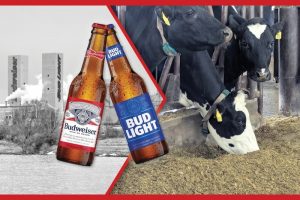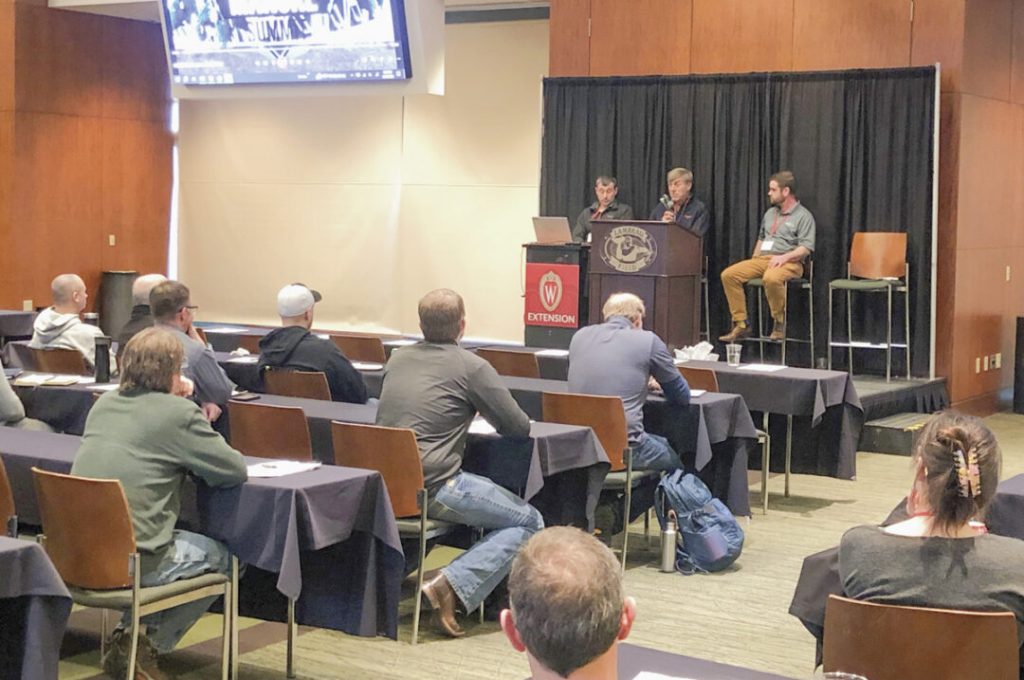What opportunities are available to create more value from dairy waste?


What opportunities are available to create more value from dairy waste?
That question seemed to preface many presentations at the 2025 Midwest Manure Summit in Green Bay, Wisconsin. For three individuals, creating more value lay in what was available to them and the relationships they were willing to build with neighbors and industry stakeholders. Scott Hynds, a senior service technician with Aqua Innovations LLC; John Rosenow, co-owner of Rosenow Dairy and Cowsmo Compost; and Brent Cousin, general manager of Holsum Dairies, participated in the panel discussion, “Manure processing systems,” moderated by Rebecca Larson with the University of Wisconsin Extension.
Hynds works with dairy producers to transform manure into clean discharge water through membrane technology, which also results in fertilizer products and creating nutrient recovery systems.
Both Rosenow and Cousin are dairy producers of varying sizes. Rosenow and his wife own a 600-cow dairy and use the manure from their farm and that from another 150-cow dairy to create potting soil and compost, a business that is about 25 years old. Cousin oversees two farm sites totaling about 8,500 cows, where the manure is processed through anaerobic digesters for renewable natural gas (RNG) production. The manure at Holsum Dairies is also put through a solid separator and used as bedding. Remaining manure nutrients are sold to crop growers surrounding the farms as fertilizer for the feed purchased for the dairies.
HYNDS: Our challenge was to figure out how to get enough manure from the cow to put into the membrane technology. There’s a lot of technology out there, as far as solid separation, and not every farm is going to have the same setup. For us to be successful, we’ve had to figure out how can we work with what’s existing – digester, no digester, screw press – and adapt. As we move forward, we’ve got to continue to look at what’s out there and what can we improve so that it makes sense for reducing how much it costs and minimizing [operating expenses].
ROSENOW: We have three major challenges. One would be that we designed our compost facility with DNR approval back in 1997. They’ve changed their rules, so now it’s not in compliance. We have to do something about that. The second thing is marketing of compost and our potting soils. It used to be fairly easy with going to trade shows and talking to people there and building the market that way. But nobody goes to the trade shows anymore, so that has changed dramatically. The third would be the rhetoric for our employees. We have lots of employees who are very, very good but the rhetoric in the country right now is detrimental to keeping them.
COUSIN: I think that one of the major challenges we face is cost. We continually see the cost, particularly in transportation, climb. Cost of handling, moving, dealing with the manure, it’s on a steady trend up and it’s increasing faster, I think, than other costs. But we’re in a situation where we can strategically apply our manure based upon its composition. That’s helpful. That really is a big benefit to us on how we can get it distributed.
HYNDS: There is heartburn relief, in a way, that we’re looking at taking less manure and putting it in the pits. [Public relations] is a big deal, and we understand that, and we want to be a partner with farmers on being able to market and say, “Hey, we’re doing the right thing, and we’re on the forefront environmentally and we’re being responsible.” Working together, partnering with the community and taking the right steps are all really good things.
ROSENOW: We don’t compost our manure for fun. We do it for money, and so it took us a few years to get profitable. Now, let’s say it’s a nice income source when milk prices are lousy, and we count on it quite a bit.
COUSIN: We’ve always found value in the biogas. There were times and years when electrical generation did very well. That fell off, but at no point did it ever become a cost. It was not very profitable for many years. But then with California fuel credits and RNG, it has really become a great diversity of our overall income. I do believe biogas is going to continue to be a valuable asset for the dairies. Our focus has been on how we get more out of it.
HYNDS: We know how to make water. We don’t know crap about crap, you know, but learning that there’s so much value in the nutrients, and there’s so much value being able to partition the nutrients, like phosphorus and nitrogen. We’re working with smart people and going through studies and figuring out what is the best way to handle this. When you have two unique nutrient streams that you can commingle and custom-tailor your nutrient blend per land application, it creates flexibility that wasn’t there previously.
ROSENOW: We try not to have enough land to apply after producing compost. We don’t want to farm thousands of acres of land. We’d rather just milk cows. That was kind of the beginning of why we started to sell that stuff the first year. I think we gave it away because it’s manure, and I remember having meetings with people who don’t get excited because it’s still manure and we compost it. Today, we ship it out by semi loads. We have one account in the Twin Cities area that took 42 semi loads last year. I tell people at trade shows that I never in my life dreamed I would be pitching manure in downtown Minneapolis.
COUSIN: With our system, we can utilize our manure strategically. It allows us to take thinner manure, apply it at higher rates, closer to the farm and all our new farms, further away that we’re putting on the semi. One thing I think that’s key for us when we look at selling it, is we take about 60 to 100 samples of manure annually as it’s going out, so verifying that when we’re dealing with a grower, they know exactly what they’re getting on their feed. Being able to gain that trust and have that information has been the key to the success of that system.
HYNDS: We’re constantly monitoring all of our operational performance data. Discharge is something that needs to be monitored closely with smart onboard sensors and information. As far as success, it’s easy to do, but it’s not easy to do for long term. So that [operating expense] over time becomes a really important thing because you can take a filter and you can run stuff through it and it comes out clear, but to do it over and over again, day after day, and not have to replace that filter every single time.
ROSENOW: When we first started this, we were very careful not to use the word “manure” on it because people kind of shied away from that. But now we have it on our label because the word has become very popular. When we’re selling to gardeners and people like that, they want to know if it’s from dairy manure. And then it’s a positive and their eyes light up. It doesn’t smell. It’s black, it’s moist, and also it doesn’t look like the stuff that you buy in Menards or someplace else.
COUSIN: For manure generation, we look at how much manure we apply every year. We only get that number once a year. We evaluate that on a per-cow basis just to monitor how we’re doing year over year, trying to limit that as much as possible. Also looking at costs, we look at our application, how much, what percentage went through a hose, what percentage was used directly in the field with trucks. If you look at our bedding dryer, we’re typically monitoring every aspect of milk quality, clinical mastitis, somatic cell count, those sorts of things to make sure that bedding dryer is functioning as it’s supposed to. On the digester end, biogas production, biogas quality.
You can now read the most important #news on #eDairyNews #Whatsapp channels!!!
🇺🇸 eDairy News INGLÊS: https://whatsapp.com/channel/0029VaKsjzGDTkJyIN6hcP1K
Legal notice about Intellectual Property in digital contents. All information contained in these pages that is NOT owned by eDairy News and is NOT considered “public domain” by legal regulations, are registered trademarks of their respective owners and recognized by our company as such. The publication on the eDairy News website is made for the purpose of gathering information, respecting the rules contained in the Berne Convention for the Protection of Literary and Artistic Works; in Law 11.723 and other applicable rules. Any claim arising from the information contained in the eDairy News website shall be subject to the jurisdiction of the Ordinary Courts of the First Judicial District of the Province of Córdoba, Argentina, with seat in the City of Córdoba, excluding any other jurisdiction, including the Federal.
1.
2.
3.
4.
5.
eDairy News Spanish
eDairy News PORTUGUESE
